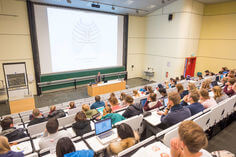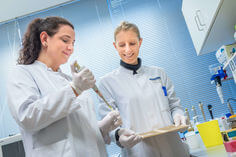Funktionelle Neuroanatomie - AG-Wieland
Gruppenleiter
Dr. med. Sebastian Wieland
Facharzt für Psychosomatische Medizin und Psychotherapie
Funktionsoberarzt
Juniorgruppenleiter AG Neural circuits of stress and affective disorders
(Funktionelle Neuroanatomie, Institut für Anatomie und Zellbiologie)
Neural circuits of stress and affective disorders
THE PROBLEM:
The ability to regulate internal emotional states is a key mental function. Balancing internal emotional states enables to properly respond to environmental conditions. In contrast, deficits in emotion homeostasis can lead to mental disorders with strongly reduced behavioral flexibility. In stress disorders like PTSD or chronic pain – often seen as a somatic variant of PTSD- patients experience intrusive and hyperarousal states and thus avoid unpleasant triggers. Stress disorders are often complicated by comorbid affective disorders - e.g. depression and anxiety disorders – that worsen behavioral flexibility. Unfortunately, complex stress disorders often do not respond to conventional therapeutic strategies. The development of novel therapeutic approaches for stress and affective disorders remains challenging as a mechanistic (cellular/ circuit) understanding is widely missing.
THE APPROACH:
Our group seeks to understand single neuron and neural circuit activity that regulates internal emotional states in the disease brain in order to develop translational therapy models. On one hand, we are investigating how neural plasticity in the limbic system contributes to behavioral adaptations in animal models of chronic pain and (complex) PTSD. We have chosen thalamolimbic projections as our model system where we use a multidisciplinary approach of in-vitro and in-vivo recordings, naturalistic behavioral assays and multi-color optogenetics. On the other hand, we are investigating how bilateral stimuli can affect internal emotional states in an animal model of EMDR psychotherapy. We use classical conditioning with multisensory stimulations in combination with animal videography, chemogenetics and in-vivo fiber photometry.
KEY PUBLICATIONS:
Jauch I, Kamm J, Benn L, Rettig L, Friederich HC, Tesarz J, Kuner T, Wieland S. 2MDR, a Microcomputer-Controlled Visual Stimulation Device for Psychotherapy-Like Treatments of Mice. eNeuro. 2023 Jun 2;10(6):ENEURO.0394-22.2023.
www.eneuro.org/content/10/6/ENEURO.0394-22.2023.abstract
Gan Z, Gangadharan V, Liu S, Körber C, Tan LL, Li H, Oswald MJ, Kang J, Martin-Cortecero J, Männich D, Groh A, Kuner T, Wieland S, Kuner R. Layer-specific pain relief pathways originating from primary motor cortex. Science. 2022 Dec 23;378(6626):1336-1343.
Oettl LL*, Scheller M*, Filosa C*, Wieland S, Haag F, Loeb C, Durstewitz D, Shusterman R, Russo E*, Kelsch W* (* equal contribution); Phasic dopamine reinforces distinct stimulus encoding in the olfactory tubercle driving dopaminergic reward prediction. Nature communications 2020 Jul 10;11(1):3460
Wieland S, Schindler S, Huber C, Köhr G, Oswald MJ, Kelsch W. Phasic Dopamine Modifies Sensory-Driven Output of Striatal Neurons through Synaptic Plasticity. J. Neurosci. 2015 Jul 8;35(27):9946-56.
Kelsch W*, Li Z*, Wieland S*, Senkov O, Herb A, Göngrich C, Monyer H. GluN2B-containing NMDA receptors promote glutamate synapse development in hippocampal interneurons. J. Neurosci. 2014 Nov 26;34(48):16022-30. (* equal contribution)
Wieland S, Du D, Oswald MJ, Parlato R, Köhr G, Kelsch W. Phasic dopaminergic activity exerts fast control of cholinergic interneuron firing via sequential NMDA, D2, and D1 receptor activation. J. Neurosci. 2014 Aug 27;34(35):11549-59. (cover article, highlighted by the editor)
THE PEOPLE:
"The objective of my research is to better understand how pain-induced plasticity in single neurons shapes the development of maladaptive behavior in mice. Hence, I combine opto-/chemogenetical manipulations of thalamolimbic projections with patch-clamp and behavioral recordings in a mouse model of neuropathic pain."








